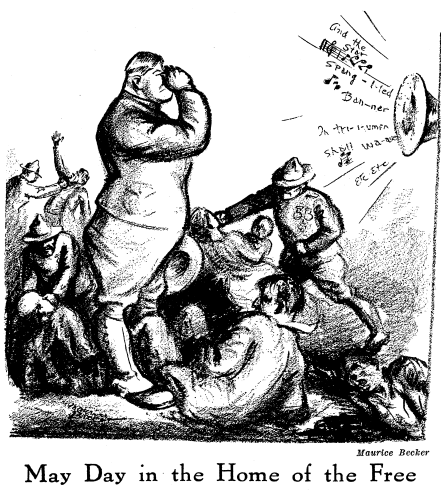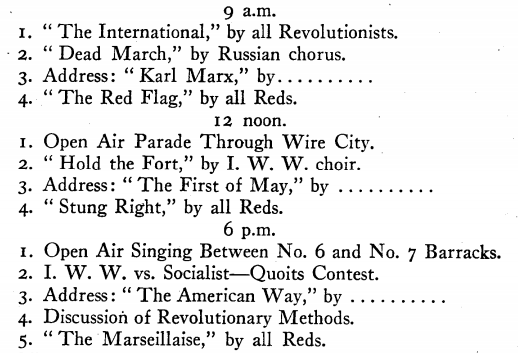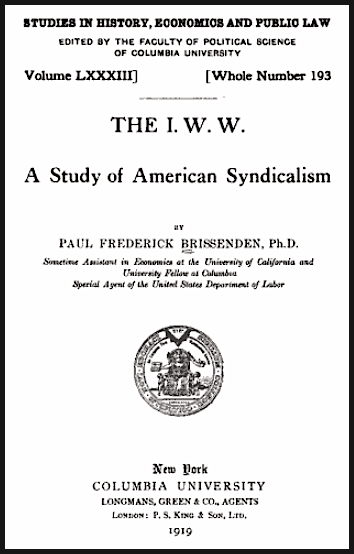 ———-
———-
Hellraisers Journal – Sunday June 8, 1919
May Day Celebrated at Ft. Leavenworth by Reds of All Stripes
From The Liberator of June 1919:
May Day in Ft. Leavenworth
By a Socialist C. O.
WHILE Cleveland was having its fatal May Day demonstration and while other free American cities were engaged in bloody rioting and fighting between citizens and police, with soldiers pitching in on both sides and shavetail ex-officers going into “action” for the first time, the militant Socialists imprisoned in Fort Leavenworth were observing the international revolutionary Labor Day under U. S. military sanction.
The open air red flag parade was witnessed by a crowd of soldiers who offered no opposition but viewed it with apparent approbation. The one day stoppage of prison work by the celebrants met with the approval in advance of the prison authorities who made special arrangements to permit the rebel group to assemble and observe the day. Civilians and Q. M. sergeants and children on their way to school looked with amazement on the unprecedented prison scene as it unfolded itself behind the double lines of barbed wire surrounding the stockade-annex of the Disciplinary Barracks.
The sensational feature of the day that will make it a bright red memory for the amazed officers; the grinning soldiers and the triumphant laborites was this grand parade through “Wire City.” It formed in front of the Bolsheviki Barracks, as the Socialist prison quarters are jocularly called, right after dinner. Red flags and banners were distributed among the 90 or 100 marchers. The winter hoods issued by the prison clothing department and lined with flaming red flannel were worn turned inside out. The covers of the Liberator bearing pictures of Lenine and Lincoln (Liebknecht’s had been lost) were tied on brooms and borne aloft as sacred emblems. The Russians, as citizens of a bonafide revolutionary country, held the place of honor, leading the parade and chanting the Revolutionary Dead March and other Bolshevik songs. Then came Italian Socialists and Anarchists, American Socialists and aliens and Pacifists and, bringing up the rear, the handful of I. W. W.’s.
In and out between the stockade buildings the remarkable demonstration proceeded while sentries looked down dumbstruck from the watch-towers and the guards on duty within stood passively by. After the parade was half over, it reversed itself so that the I. W. W., starting up their songs, led the rest of the procession until it disappeared within the’ Bolsheviki Barracks. One soldier was observed leaning out of a window-the guard’s barrack, waving a red ribbon. Many others cheered and applauded.
Suddenly the soldiers hushed and the deferential demeanor a soldier learns to display before his superiors indicated the appearance of officers on the scene. From the Bolsheviki Barracks came deafening cheers for the revolution, for Karl Marx for Eugene Debs, for Lenine, Trotsky and Liebknecht. One of the “agitators” responsible in large part for arrangements went out and met a lieutenant-colonel, a captain, a lieutenant, several corporals and a number of buck privates.
“This must be stopped. I feel that you men have abused the privilege I gave you,” declared the senior officer. He was smilingly assured that there would be no more disturbance, since the parade was over and the rest of the program was chiefly speech-making. He was informed further that there had been no thought of abusing any privileges since permission had been given to “observe the day,” and no May Day anywhere could be properly “observed” without red flags and a parade. The celebrators were so hilarious and also so completely satisfied with the success of their demonstration that they were content to let, matters rest. Speeches were made, discussions went on and a general rejoicing was everywhere evident.
The program as posted on the bulletin board in the morning read (names omitted):
The panic of the officers caused the remainder of the singing to be omitted, and a delay in supper forced postponement of the Wobbly-Socialist horseshoe throwing contest; but the speaking gained in nerve and spirit, and as reports drifted in of the glad surprise with which the other prisoners heard of the affair and of the helpless consternation among the authorities who had to recognize that nothing unlawful had occurred, the memorable day drew to a jubilant close.
Permission for the observance had been won by reminding the officials of similar permission granted to the Jews for commemorating Passover and the like, indulgence granted to Seventh Day Adventists and others. And it was not stretching the truth at all when the representatives of the militant Socialists said to the executive officer what all-revolutionaries can proudly say: “The First of May, May Day, is the most sacred day in the year to us, as sacred as Passover to the Jews, as Christmas to the Christians, as the Fourth of July to nationalistic Americans. May Day is our international revolutionary memorial day.”
[Emphasis added.]
[Cartoon added is by Maurice Becker, from page 28 of same issue.]
Book Review from the June 1919 Liberator:
The Facts at Least
[by Floyd Dell]
The I. W. W.: A Study of American Syndicalism, by Paul Frederick Brissenden, Ph.D., Sometime Assistant in Economics at the University of California and University Fellow at Columbia. Special Agent of the Department of Labor. Columbia University Studies in History, Economics and Public Law. Longmans, Green & Co.
THIS volume is a splendid compliment to the I. W. W. It is a fat book of 432 pages, which deals exhaustively with the whole stormy career of the organization, from its inception in 1905, through the series of struggles between the various elements among its founders, down to its reorganization and subsequent participation in the labor history of these times. It goes fully into all the theories, presents every salient personality, describes the line-up at every convention, quotes from every important speech and pamphlet. It has a masterly bibliography. It is accurate, exhaustive, impartial-in short, just the kind of history of the I. W. W. which no one (with exceptions which I shall note presently) happens to need.
If it were a history of the Union League Club, for example, it would be possible to imagine the reminiscent and sentimental gusto with which some elderly charter member would sit down by his fireside to while away the long winter evenings by fighting over again in its pages the battles of days agone. But the wobbly of today, if he is really on the job, is too much interested in the present and the future to linger over this careful piece of embalming. This book is not, of course, primarily written for Wobblies; its price indicates that at the outset. Well, then, whom is it written for? Not for the general public, which however needful of being enlightened about the I. W. W., is not going to make that subject its life’s study. And scarcely for the college student of economics, who is going to find its minutiae of internal contention about as illuminating as he would an equally exact account of the Wars of the Roses.
This is not intended as disparagement of Professor Brissenden’s unmistakable and in fact extraordinary abilities as a historian; but rather as a protest against his misuse of those abilities. It is a refreshing change, so far as that goes, to find a history dealing in exquisite detail with the quarrels of revolutionary labor organizers and theorists, rather than with the battle and scandal of the ancien regime. But the origins of the I. W. W. in economic and political conditions, its coming into existence as a result of the deflection alike of the A. F. of L. and the Socialist Party from their true aims-in a word, its conscious assumption in whatever degree of the historic mission of the working-class, is so significant that the accidents and incidents of its early years become of importance only as they illustrate that aspect of the theme.
Such a history could, however, only be written by one who had a definite view as to the merits of the I. W. W. as protagonist of the revolutionary proletariat. Such a historian would make no pretensions to academic impartiality, however much he might strive for historic truth; he would know whether or how far St. John or De Leon was right, and would undertake to explain why in a few persuasive pages instead of carefully dodging the issue in many; and he would necessarily address his book to the working-class, in order to show them by the history of the past what courses they should adopt in the future. That book would be neither impartial nor exhaustive, and its condensation of complex squabbles would necessarily be less accurate than this full-length account of them-but it would be a tremendously useful and important book
It is high time that were written. The I. W. W. is not a fixed institution, not a finished product, and it need not be studied by historic entomologists as if it were. It is the still-evolving embodiment of certain terrifically significant forces, which have not yet made their full concussion upon society. It needs to be studied in this light; and those who want to write such a history will find a considerable part of his materials already digested and arranged and ready to hand in this present volume. To such persons the book will be of enormous convenience. Professor Brissenden has compiled and edited with illuminating and judicious commentary, an admirable source-book of I. W. W. history.
F. D.
P. S.-There is only one reason, however, why Professor Brissenden should not himself write such a history as we have described. His first intention, he says in his preface, was to incorporate in this volume “an attempt at an analysis and interpretation of I. W. W.-ism, as well as its orientation with other economic isms.” And he is “not unmindful of the fact that the interpretation of such a significant movement as is embodied in the Industrial Workers of the World is of great importance.” Professor Brissenden has only to ask himself, “Importance to whom?” and answer the question correctly, to become a benefactor of no small moment to the working-class movement.
It is exquisitely improbable, however, that his book of “interpretation” will be published by Columbia University; a mass of uninterpreted facts can hope for the sanction of a respectable academic body in these days, but scarcely a true statement of the revolutionary significance of such facts! That, as Professor Brissenden will come to realize, constitutes Bolshevik propaganda, and will subject him to the rigors of Senatorial inquisition. He had better think twice before he ventures into the dangerous field of truth-(i. e., not mere fact)-telling!
[Photograph and emphasis added.]
~~~~~~~~~~~~~~~~~~~~~~
SOURCES
Quote EVD re Unity for May Day 1919, fr SPA Program
http://www.marxisthistory.org/history/usa/parties/spusa/1919/0501-debs-maydayspeech.pdf
The Liberator
(New York, New York)
-June 1919
https://www.marxists.org/history/usa/culture/pubs/liberator/1919/06/v2n06-jun-1919-liberator.pdf
IMAGES
May Day in USA by Maurice Becker, Liberator p28, June 1919
https://www.marxists.org/history/usa/culture/pubs/liberator/1919/06/v2n06-jun-1919-liberator.pdf
IWW by Brissenden, Cover, 1919
https://play.google.com/books/reader?id=4QkAAAAAYAAJ&printsec=frontcover&pg=GBS.PA3
See also:
Tag: May Day
https://weneverforget.org/tag/may-day/
May Day
-by Philip S. Foner
International Publishers, 1986
(search: may day 1919)
https://books.google.com/books?id=8oXpyXXavIkC
May Day Riots of 1919
https://en.wikipedia.org/wiki/May_Day_riots_of_1919
New Solidarity of May 10, 1919
https://www.sos.wa.gov/legacy/publicationsviewer/?title=New%20Solidarity&page=5&id=271
Ohio Socialist
May 8, 1919
https://www.marxists.org/history/usa/pubs/ohio-socialist/067-may-08-1919.pdf
May 14, 1919
https://www.marxists.org/history/usa/pubs/ohio-socialist/068-may-14-1919-ohio-soc.pdf
The I. W. W.
A Study of American Syndicalism
-by Paul Frederick Brissenden, Ph.D
Columbia U, New York, 1919
https://books.google.com/books?id=4QkAAAAAYAAJ
https://babel.hathitrust.org/cgi/pt?id=coo1.ark:/13960/t4vh63d35&view=2up&seq=6
https://archive.org/details/iwwstudyofameric00brisuoft/page/n7
~~~~~~~~~~~~~~~~~~~~~~~~~~~~~~~~~~~~~~~~~~~~~
The Red Flag – Songs of Irish Labour
Lyrics by Jim Connel, 1889
https://www.marxists.org/subject/art/music/lyrics/en/red-flag.htm
Look ’round, the Frenchman loves its blaze,
The sturdy German chants its praise,
In Moscow’s vaults its hymns are sung
Chicago swells the surging throng.
Then raise the scarlet standard high.
Within its shade we’ll live and die,
Though cowards flinch and traitors sneer,
We’ll keep the red flag flying here.



